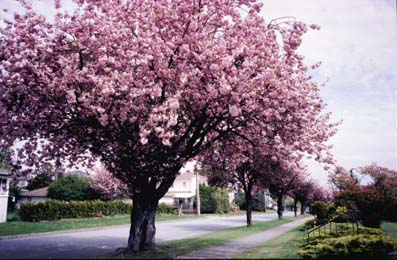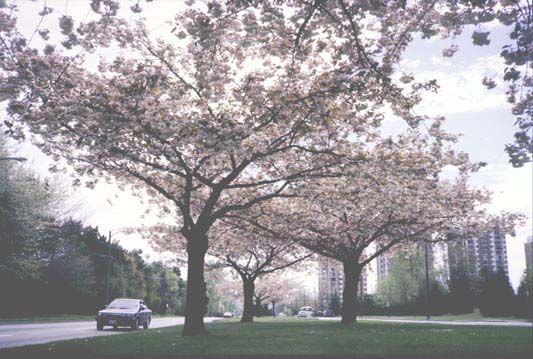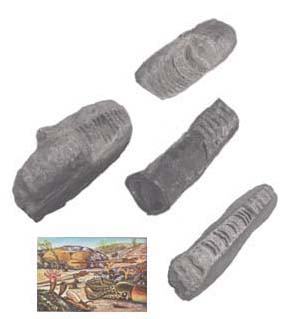equinox

double pink cherries

yoshino cherries
As if controlled by the strange lever-wielding *man in the planet* character in Eraserhead, the season has once again lurched into gear and I find myself inundated by the seething fecundity of spring. The trumpeter swans have already migrated over this little island, in wheezing, flapping north-bound skeins, having spent the winter grazing on the sweet green swards of the Comox Valley. Now the year’s first vultures are lazily spiraling up the thermals, gazing casually down at me as I cross the meadow in case maybe, just maybe, I suddenly drop dead. Crocuses and pussy willows have come and gone, giving way to cadmium-yellow daffodils and the libidinous trilling of frogs.
The suburban landscapes of Victoria and Vancouver are lysergic with a display of botanical rococco. Band-Aid pink blossom clouds of Japanese cherries billow over glistening streets, the drifts of their fragrant benedictions piling up on parked cars. Forsythias explode from behind chain-link fences, like blinding showers of sparks from the grinding of metal. Purple hyacinths erupt unabashedly though the dog doo-dooed detritus of a long grey winter.
Of course, we might have to kiss all of this natural splendor good-bye, as the signs of what is being called “The 6th Great Extinction” are starting to really pile up. They’re little things, each of them, but when taken in total, they point to an unprecedented human-initiated crash in biodiversity that is, right this minute, leading to a massive impoverishment of the planet’s natural infrastructure. The above link functions as kind of an “extinct-o-meter” and really gives a sense of the *cumulative* nature of this crisis. It really is the death by a thousand needles.
A typical news story this week reports on an exhaustive study of butterfly biodiversity which found that an astonishing 71% of British butterfly species declined over the past 20 years. So what? you might ask, but many butterflies have symbiotic relationships with the plants they pollinate, and they in turn will go extinct without the butterflies to pollinated them. Of course butterflies and their nocturnal moth cousins are vulnerable to the insecticides used everywhere in agriculture, but lately, they are being killed en-masse by crops such as corn, which have been genetically engineered to produce the Bt toxin. The insecticidal *pollen* from this corn can be carried great distances in the wind and has been implicated in the sharp decline of such familiar species as the North American monarch butterfly. As children growing up in suburban Toronto, we used to collect the spectacular, Cercropia, Polyphemus and Luna moths and would bring them to school alive in cookie tins. Now these exquisite creatures seem to have largely vanished and today’s suburban children will only ever see them in museum displays or on video.
As well as killing butterflies, genetically engineered pollen risks destroying the very genetic commons that has allowed corn to survive climate change, pests and diseases for millennia.. Corn is a product of 9,000 years of symbiosis and coevolution between the human cultures of the Americas and a now vanished wild plant. Within the gene pool of the diversity of traditional Mexican corn varieties, reside the genetic algorithms containing corn’s history and its armamentarium of strategies to adapt to changing conditions. These ‘libraries’ are now being contaminated by pollen from (unlabelled) genetically engineered corn that was imported into Mexico via the United States. It was originally meant for animal feed but wound up getting planted by poor farmers, who couldn’t afford to buy seed corn. This germ-plasm contamination is one of the worst case scenarios that anti-GMO activists have been predicting during the last few years and now that it has come to pass, it really underscores the demented-ness of not having labelling requirements for GMO materials that are distributed in the United States and Canada.
Somewhat perversely, one of the outcomes of widespread GMO pollution is the emergence of an entire industry providing testing services for markets that *don’t wan’t to be contaminated* with what agrobusiness is trying to ram down the world’s throat. For example, IdentiGen tests foods for GMO content and will issue a ‘Non-GMO’ certificate for products that prove uncontaminated by them. A ‘GMO free’ status has now become an attractive value proposition for many food manufacturers. It is easy to understand why agribusiness is deliberately contaminating our airsheds with as much GMO pollen as possible, in order to ultimately prevent their organic competitors from successfully achieving market differentiation, by keeping their crops ‘GMO free.’ Organic farmers in the US are already finding GMO pollution in their fields and are increasingly fearful that their $10 billion-a-year industry will be rejected by European consumers, used to tighter regulation.
Although GMOs are doubtlessly playing their part in the current mass extinction episode, it is perhaps worth remembering that the Earth has suffered through them before, albeit not (to my knowledge) as a result of the deliberate stupidity of a single *virus* species like Homo sapiens. My old friend Ian has been studying fossils of extinct forests and he sent me his treatise on “Morphotyping the McAbee Flora” (unfortunately not archived online) in which he starts to catalog the exquisite paleobotany of a Kamloops BC area sedimentary deposit, dating from the Eocene era, 55 million years ago. Before the mass extinction event that occured at the end of *that* unusually warm period, the now dry and cold interior of British Columbia was covered in a lush and highly diverse mixture of temperate and subtropical trees such as Ginkgo, Metasequoia, Sassafras and Sycamore as well as many other species that have passed into extinction. The leaves and seeds of these trees left exquisite impressions in the area’s fine grained, silty rock and Ian is working on a digital photo archive of these fossils. (This would seem to be a great application for Plone’s CMFPhoto product, perhaps accompanied by lively zwikis in which the identity of the mysterious “incertae” could be discussed)
Ian and I went to art school together in Toronto, a city which, in prehistory like the planet Mars, had been inundated by a warm ocean. Growing up in its suburbs, I watched the landscape which had been buccolic and rural during my childhood, get transmogrified into a Ballardesque wasteland of shopping malls and industrial parks, by the time I was an adolescent. Throughout the devastated farmland, pock-marked by countless excavations for the foundations of new parking garages and tract homes, lay huge gray spoil piles of shale and mudstone, through which I used to pick to find almost perfect lithographic impressions of sea creatures such as scallops, corals and sea-lilies. These fossils were all that remained the ancient Ordovician ocean that had covered the area 450 million years ago. I would often collect curiously sectored, cornucopia-shaped objects, beautifully petrified, for which there seemed to be no contemporary equivalent. These proved to be the remains of cephalopods and nautiloids – long extinct squid-like creatures whose tentacled heads emerged from a kind of chambered tusk which they propelled backward through the limpid coralline sea.

Cephalod fossils I collected in suburban Toronto
The presence of these invertebrate fossils seemingly scattered all over its landscape, produced some remarkable effects on Southern Ontario’s culture. Marshal McLuhan, for example, appeared in a widely circulated photograph (taken by the famous Canadian photographer Karsh) posed in front of the seminal, interactive *invertebrate paleontology* exhibit at the Royal Ontario Museum. I remember being beguiled by this exhibit (designed by McLuhan’s associate Harley Parker) when I first saw it as a young boy, and I dutifully picked up the telephone receivers and listened to reassuring narratives on the evolution and subsequent extinction of the trilobites. Somehow this put the ecological carnage I saw wrought by the metastasizing development industry, into some kind of long-term perspective.

Marshall McLuhan *extends* Invertebrate Paleontology
Inspired by such fossils, the remarkable poet Christopher Dewdney wrote the wonderful “A Palaeozoic Geology of London, Ontario” in 1973, which ironically has become a rare fossil in itself, because (according to one source):
workmen involved in a move (at the publisher, Coachhouse) inadvertently pitched most of the unbound copies of the limited edition into the garbage.
These were the days before digital backup and on-demand publishing.
Fossilized reefs and inundation figure prominently in the work of J. G. Ballard, for example in The Drowned World (1962) and The Cloud -Sculptors of Coral D (1973). Last week, the venerable self-described *terrorist-novelist* gave an amazing interview on BBC World’s Profiles series. The interview was shot in various bleak suburban locations in Shepperton near Heathrow Airport. In describing these environments Ballard said:
The equivalent of the desert today are these large shopping malls and industrial parks, which allow the imagination begin to fester . . . where the individual is sort of finessed out of existence. . . .
I was pleased to see Ballard’s review of Mike Davis’ brilliant book – Dead Cities in the Guardian last spring. Davis’s books are very blog-like; quite non-sequiturious and essay-like. Dead Cities has a particularly interesting chapter on ruderal ecologies entitled “Dead Cities: A Natural History” in which Davis describes the stages of succession that nature follows to reinvade the built environment, especially after humans have been temporarily displaced by (for example) bombing or as in the case of Chernobyl – radioactive fallout. Even in our bleakest rubble fields and toxic waste dumps, hope does indeed spring eternal. . .




well, be happy to know that nyc is solely lysurgic by dint of its culture, not nature. sad. true. i’m sure we’ve lost many a nematode and housepet. me, i have my lopper out, ready to combat any leaf-dropping holly. making a butchery out of trying to control nature in my own back yard.
sorry to be so apolitical; i mostly wanted to say hello and audible admire your blogging.